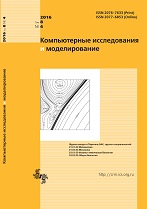|
This article is cited in 1 scientific paper (total in 1 paper)
COMPUTER SCIENCE IN SPORT
Effects of the heart contractility and its vascular load on the heart rate in athlets
V. R. Orela, R. V. Tambovtsevaa, E. A. Firsovab
a Russian State University Of Physical Culture, Youth Sports And Tourism,
4 Sireneviy st., Moscow, 105122, Russia
b The branch of Russian state social University in Klin,
20/1 Volokolamsky st., Moscow region, Klin, 141607, Russia
Abstract:
Heart rate (HR) is the most affordable indicator for measuring. In order to control the individual response to physical exercises of different load types heart rate is measured when the athletes perform different types of muscular work (strength machines, various types of training and competitive exercises). The magnitude of heart rate and its dynamics during muscular work and recovery can be objectively judged on the functional status of the cardiovascular system of an athlete, the level of its individual physical performance, as well as an adaptive response to a particular exercise. However, the heart rate is not an independent determinant of the physical condition of an athlete. HR size is formed by the interaction of the basic physiological mechanisms underlying cardiac hemodynamic ejection mode. Heart rate depends on one hand, on contractility of the heart, the venous return, the volumes of the atria and ventricles of the heart and from vascular heart load, the main components of which are elastic and peripheral resistance of the arterial system on the other hand. The values of arterial system vascular resistances depend on the power of muscular work and its duration. HR sensitivity to changes in heart load and vascular contraction was determined in athletes by pair regression analysis simultaneously recorded heart rate data, and peripheral ($R$) and elastic ($E_a$) resistance (heart vascular load), and the power ($W$) of heartbeats (cardiac contractility). The coefficients of sensitivity and pair correlation between heart rate indicators and vascular load and contractility of left ventricle of the heart were determined in athletes at rest and during the muscular work on the cycle ergometer. It is shown that increase in both ergometer power load and heart rate is accompanied by the increase of correlation coefficients and coefficients of the heart rate sensitivity to $R$, $E_a$ and $W$.
Keywords:
heart rate (HR), blood pressure, phase intervals of the cardiac cycle, vascular resistance, sensitivity coefficient, correlation coefficient, contractility, heart rate power.
Received: 21.11.2016
Revised: 22.01.2017
Accepted: 03.03.2017
Citation:
V. R. Orel, R. V. Tambovtseva, E. A. Firsova, “Effects of the heart contractility and its vascular load on the heart rate in athlets”, Computer Research and Modeling, 9:2 (2017), 323–329
Linking options:
https://www.mathnet.ru/eng/crm66 https://www.mathnet.ru/eng/crm/v9/i2/p323
|

| Statistics & downloads: |
| Abstract page: | 239 | | Full-text PDF : | 96 | | References: | 33 |
|




 Contact us:
Contact us: Terms of Use
Terms of Use
 Registration to the website
Registration to the website Logotypes
Logotypes








 Citation in format
Citation in format 
